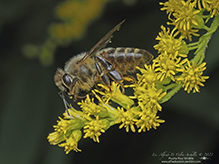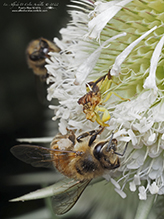western honey bee
(Apis mellifera)
Conservation • Description • Habitat • Ecology • Distribution • Taxonomy
Conservation Status |
|
|||||||
| IUCN Red List | not listed |
|||||||
| NatureServe | NNR - Unranked |
|||||||
| Minnesota | not listed |
|||||||
Description |
||
There are seven species of honey bee, all in the genus Apis. None are native to North America. Western honey bee (Apis mellifera) was introduced into North America in the early 1600s and is now found worldwide. African honey bee (Apis mellifera scutellata) is a subspecies of western honey bee. |
||
Size |
||
|
||
Similar Species |
||
Habitat |
||
|
||
Ecology |
||
Season |
||
|
||
Behavior |
||
|
||
Life Cycle |
||
|
||
Larva Food |
||
|
||
Adult Food |
||
|
||
Distribution |
||||
|
Sources |
|||
| 9/20/2024 | ||||
Nativity |
||||
Native to Europe, Asia, and Africa. Introduced into North America in the 1600s. |
||||
Occurrence |
||||
Widespread and common. |
||||
Taxonomy |
|||
Order |
Hymenoptera (Ants, Bees, Wasps, and Sawflies) | ||
Suborder |
Apocrita (Narrow-waisted Wasps, Ants, and Bees) | ||
Infraorder |
Aculeata (Ants, Bees, and Stinging Wasps) | ||
Superfamily |
Apoidea (Bees and Apoid Wasps) | ||
| Epifamily | Anthophila (bees) | ||
Family |
Apidae (honey bees, bumble bees, and allies) | ||
Subfamily |
Apinae (honey, bumble, longhorn, orchid, and digger bees) | ||
Tribe |
Apini (honey bees) | ||
Genus |
Apis (honey bees) | ||
| Subgenus | Apis (cavity-nesting honey bees) | ||
Synonyms |
|||
Apis mellifica |
|||
Common Names |
|||
European honey bee western honey bee |
|||
Visitor Photos |
|||||
Share your photo of this insect. |
|||||
| This button not working for you? Simply email us at info@MinnesotaSeasons.com. Attach one or more photos and, if you like, a caption. |
|||||
Luciearl |
|||||
 |
 |
||||
Alfredo Colon |
|||||
 |
|||||
 |
 |
||||
 |
 |
||||
 |
 |
||||
 |
 |
||||
 |
 |
||||
Dan W. Andree |
|||||
Ambush Bug caught a Honey Bee... August 3, 2022 on a prairie in Norman Co. Mn. Was hard to photograph the prairie flower it was on kept swaying in the breeze. |
 |
||||
Honey Bee... |
|||||
 |
|||||
Krista Takemoto |
|||||
Rare sighting. Save the bees! |
|||||
 |
|||||
Gerry Garcia |
|||||
 |
|||||
Bill Reynolds |
|||||
 |
 |
||||
 |
|||||
MinnesotaSeasons.com Photos |
|||||
 |
 |
||||
 |
 |
||||
 |
|||||

Visitor Videos |
|||
Share your video of this mammal. |
|||
| This button not working for you? Simply email us at info@MinnesotaSeasons.com. Attach a video, a YouTube link, or a cloud storage link. |
|||
Dan W. Andree |
|||
| #"Western Honey Bee & White-banded Crab Spider" filmed by Dan W Andree Mar 15, 2023 |
|||
About
A Western Honey Bee & White-banded Crab Spider encounter each other on a pale almost white wild rose blossom on a Minnesota prairie. The White-banded Crab spider is trying to capture the Western Honey Bee...It was really windy that day. The video shows the encounter in regular and slow-motion. Hope you enjoy it. |
|||
Other Videos |
|||
| Apis Mellifera: Honey Bee - a slowmo short Sutton SlowMo |
|||
About
Published on Jul 24, 2014 As featured on Gizmodo, MNN.com, Yahoo News, and more. Slow motion honey bees, edited to dubstep with some interesting facts about bees. |
|||
| Honey Bee - The Golden Insect ( Apis - Mellifera ) - Mellisa AssosVideo |
|||
About
Uploaded on Nov 20, 2008 The Golden Insect is a short Documentary about this marvelous insect scientifically named ( Apis - Mellifera ) Apis is Latin for Bee - Mellifera is Greek for to bring Honey, or as is commonly known today as Honey Bee. It was shot in 1986 with the help of students from KvB College in Sydney Australia. |
|||
| Honey Bee (Apidae: Apis mellifera) on Blossoms Carl Barrentine |
|||
About
Uploaded on Jul 11, 2009 Photographed at the Rydell NWR, Minnesota (11 July 2009). "The Pedigree of Honey / Does not concern the Bee-- / A clover any time, to him, / Is Aristocracy." --Emily Dickinson |
|||


Last Updated:













